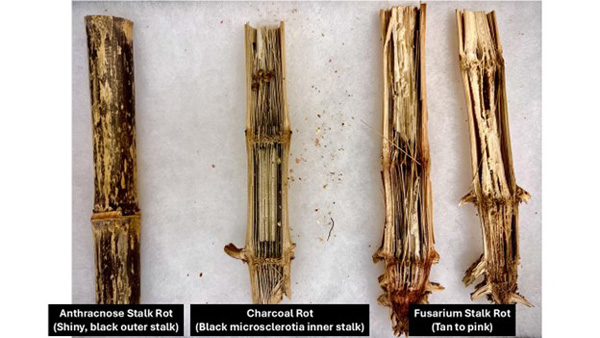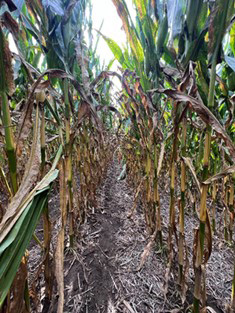Two common causes of stalk lodging are stalk rot diseases and corn borer damage. Stalk-rotting diseases in Kansas include anthracnose stalk rot, charcoal rot, Fusarium stalk rot, and Diplodia (Figure 1). Stalk-rotting diseases are present in the soil or crop residue every year. However, these diseases only develop when plants are stressed or otherwise predisposed to infection.

Figure 1. Anthracnose stalk rot, charcoal rot, and Fusarium stalk rot. Photo courtesy of Rodrigo Onofre. K-State Research and Extension.
What are the common causes of stalk lodging in corn in Kansas?
Carbohydrate depletion in the stalk during grain fill. High-yielding, “racehorse” hybrids tend to produce superior yields at the expense of late-season stalk integrity. These hybrids translocate a high percentage of carbohydrates from the stalks to the ears during grain fill. This process, which shrinks stalk diameter from flowering to maturity, weakens the stalk and makes it more prone to breakage or infection. However, these hybrids can still be excellent choices, but they require timely harvest. Consider harvesting at 20–25% grain moisture, even if discounts apply, to avoid greater losses from stalk breakage.
Hybrid differences in stalk strength or stalk rot susceptibility. Some hybrids have genetically stronger stalks than others. This is often related to a hybrid’s yield potential, as mentioned above, and how it allocates carbohydrates during grain fill. However, there are genetic differences in stalk strength for other reasons, including better resistance to stalk rot diseases. If stalk lodging occurs, hybrid choice may be part of the cause.
Poor root growth and other stresses. Poor root growth weakens stalks by limiting water and nutrient uptake. Factors such as cold or waterlogged soils, severe drought, and soil compaction can reduce carbohydrate production, forcing the ear to pull reserves from the stalk. Even under normal yields, this process can leave stalks thin and weak. The developing ear always has priority for carbohydrates within the plant.
Tar spot of corn. Tar spot is an emerging disease in Kansas that can affect stalk rot (Figure 2).
Any factor that results in poor leaf health will reduce carbohydrate production. Reduced leaf area means less photosynthesis and fewer carbohydrates for the plant, forcing stalk reserves to be mobilized (see carbohydrate depletion above).

Figure 2. Premature leaf death caused by severe levels of tar spot on corn. Photo courtesy of Rodrigo Onofre. K-State Research and Extension.
Many hybrids lack good resistance to tar spot. Producers should be ready to apply a fungicide when the disease is active and in the corn canopy.
High plant density. When plant populations are higher than optimal, stalks are often thinner and weaker (Figure 3). In addition, plant-to-plant competition for light, nutrients, and water enhances the competition for carbohydrates between the stalk and ear, thus reducing the vigor of the cells in the stalk and predisposing them to invasion by stalk rot.
Nutrient imbalances and/or deficiencies. Adequate fertility is key to stalk health. Potassium (K) and chloride (Cl) deficiencies are strongly linked to reduced stalk quality and greater lodging risk. Excess nitrogen without sufficient potassium can further increase the problem. Maintain soil chloride levels above 20 lbs/acre, and balance nitrogen with potassium to help support stalk integrity.
Corn rootworm and corn borers. Damage caused by the corn rootworm and the European corn borer can predispose the corn plant to invasion by stalk-rotting organisms, as well as lead to outright yield loss.
Mid-season hail damage. Similar to the damage caused by insects, the physical damage caused by mid-season hail can set up the plant for invasion by stalk-rotting organisms. Stalk bruising and the resulting internal damage may also physically weaken corn stalks, making them more likely to lodge later in the season.
Take-Home Message
Stalk lodging in corn results from a combination of hybrid genetics, stress during the growing season, diseases, insects, and management practices. While not all causes can be controlled, farmers can reduce risk by:
- Selecting hybrids with strong stalk strength and disease resistance.
- Managing plant populations and soil fertility.
- Monitoring for tar spot and other foliar diseases and applying fungicides when needed.
- Performing a timely harvest; harvesting susceptible hybrids early.
Once stalk rots appear in the field, there are no curative options. The best strategy is to take note of where and why lodging occurred, whether from hybrid choice, soil fertility, disease, insect pressure, or stress conditions. Understanding those contributing factors this season is critical to making management changes that help prevent the same issues in future crops.
Rodrigo Onofre, Row Crop Plant Pathologist
onofre@ksu.edu